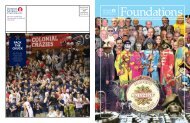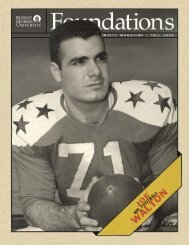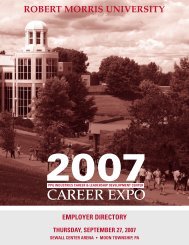"Mommy, I want you to know everything.... I am going home from <strong>the</strong> hospital today.... I amstarting kindergarten next week. I am going to wear my dress, which has flowers on it <strong>and</strong> isblack.... I wish I could fly [into] <strong>the</strong> sky to be with you." (p.196)<strong>The</strong> knowledge that a stigma is attached to AIDS, however, keeps some children from confidingthoughts like <strong>the</strong>se to o<strong>the</strong>r children <strong>of</strong> <strong>the</strong>ir age. A 16-year-old whose mo<strong>the</strong>r has AIDS, whichsome children in New York refer to as "<strong>the</strong> skinny disease," says that she has "never told a singlefriend" about her mo<strong>the</strong>r's illness. "It's like I always carry this big secret...." An eight-year-oldsays that when he feels afraid or sad while he's at school, he goes into <strong>the</strong> bathroom, to a toiletstall, <strong>and</strong> flushes <strong>the</strong> water so that nobody can hear him cry. (p.197)What is beautiful to <strong>the</strong>se children? When asked, virtually all <strong>of</strong> <strong>the</strong>m reply, "heaven." Instead <strong>of</strong><strong>the</strong> vacation spots <strong>and</strong> places that children from higher-class homes would cite as beautiful, <strong>the</strong>ychoose a place that <strong>the</strong>y know that <strong>the</strong>y could eventually get to. How do <strong>the</strong>y picture heaven in<strong>the</strong>ir imaginations? "A peaceful place with only <strong>the</strong> innocent," replies one child. (p. 125) Some<strong>of</strong> <strong>the</strong> children's visions <strong>of</strong> heaven were portrayed in simple drawings. One drawing, by a tenyear-oldboy, showed a brick wall with a large gate in <strong>the</strong> middle. Above it were eight puffyclouds. On each cloud <strong>the</strong>re is a small stick figure. Next to it is <strong>the</strong> word "me" with an arrowpointing to his head. Ano<strong>the</strong>r arrow indicates "my friends." A drawing by a 12-year-old showedheaven as "God's house" with a friendly looking sun smiling above it. In front <strong>of</strong> <strong>the</strong> house werethree angels with wings, st<strong>and</strong>ing on clouds. A sparklingly happy young girl, named Anabelle,explained what heaven is in <strong>the</strong> following quote."People that are good go up to heaven. People who are bad go down to where <strong>the</strong> Devil lives.<strong>The</strong>y have to wear red suits, which look like red pajamas. People who go to heaven wear anightgown, white, because <strong>the</strong>y are angels. All little children who die when <strong>the</strong>y are young willgo up to heaven. Dogs <strong>and</strong> kittens go up to animal heaven. But if you loved an animal who diedyou can go <strong>and</strong> visit with each o<strong>the</strong>r on <strong>the</strong> weekend. In heaven you don't pay for things withmoney. You pay for things you need with smiles." (p. 129)I was blind....Cover it up. Hide it. We don't want to know about it. <strong>The</strong> affluent don't say this with words tothis town, but <strong>the</strong>y do it with action. "<strong>The</strong> city had <strong>the</strong>se murals painted on <strong>the</strong> walls, she says,not for <strong>the</strong> people in <strong>the</strong> neighborhood—because <strong>the</strong>y are facing <strong>the</strong> wrong way—but for tourists<strong>and</strong> commuters."<strong>The</strong> idea is that <strong>the</strong>y mustn't be upset by knowing too much about <strong>the</strong> population here. It isn'tenough that <strong>the</strong>se people have to be sequestered. It is also important that <strong>the</strong>ir presence bedistinguished or 'sweetened.' <strong>The</strong> city did not repair <strong>the</strong> buildings so that <strong>the</strong> kids who livearound here could, in fact, have pretty rooms like those. Instead <strong>the</strong>y painted pretty rooms on <strong>the</strong>facades. It's an illusion." (p. 31)<strong>Kozol</strong> explains that if he talked with his white upper class friends about whe<strong>the</strong>r or not <strong>the</strong>y"impose" this life on <strong>the</strong>se people <strong>the</strong>y would react with statements about how <strong>the</strong>y simply got toNew York, worked hard at <strong>the</strong>ir jobs <strong>and</strong> settled into <strong>the</strong>ir homes. He states that, "This is that
great luxury <strong>of</strong> long-existing <strong>and</strong> accepted segregation in New York <strong>and</strong> almost every o<strong>the</strong>rmajor city <strong>of</strong> our nation nowadays. Nothing needs to be imposed on anyone. <strong>The</strong> evil is alreadyset in stone. We just move in."Some <strong>of</strong> <strong>the</strong> older generation <strong>of</strong> Mott Haven have seen too many times <strong>the</strong> acts <strong>of</strong> charity that <strong>the</strong>upper class people provide when it will make <strong>the</strong> rich feel best, for example, <strong>the</strong> food that <strong>the</strong>ydonate on Christmas. "What gonna happen on December 26? Who is this charity for? In a wayit's for <strong>the</strong>mselves so <strong>the</strong>y won't feel ashamed goin' to church to pray on Christmas Eve. Maybe<strong>the</strong>y think this way <strong>the</strong>y won't end up in hell. We have our hell right here on earth. <strong>The</strong>y'll get<strong>the</strong>irs after <strong>the</strong>ir last breath." (p. 44)Caucasians typically speak about <strong>the</strong> "<strong>the</strong>y." <strong>The</strong> "<strong>the</strong>y " that are referring to, as <strong>the</strong> cause <strong>of</strong>problems in <strong>the</strong> white neighborhoods is <strong>the</strong> African Americans in neighborhoods like MottHaven. <strong>The</strong> residents in this area <strong>of</strong> New York have a different viewpoint. <strong>The</strong> "<strong>The</strong>y" that is<strong>the</strong> issue is <strong>the</strong> decision makers that make <strong>the</strong> wrong choices according to an insightfuladolescent named Isabel from <strong>the</strong> South Bronx can cover a multitude <strong>of</strong> bases. "When we talkabout <strong>the</strong> people who are making <strong>the</strong>se decisions, we keep saying '<strong>the</strong>y' <strong>and</strong> most <strong>of</strong> <strong>the</strong> time wethink <strong>of</strong> '<strong>the</strong>y' as being white. We don't even know who '<strong>the</strong>y' might really be, yet we keepsaying '<strong>the</strong>y.' This is because we have no power to decide <strong>the</strong>se things. Something's alwayshappening where <strong>the</strong> last <strong>and</strong> final vote was not <strong>the</strong> one we made. So we say '<strong>the</strong>y did this' <strong>and</strong>'<strong>the</strong>y' seems extremely powerful, but we do not know who '<strong>the</strong>y' are." (p. 40) Isabel explains that<strong>the</strong> ones who make <strong>the</strong> decisions that are so vital to how <strong>the</strong> community lives are <strong>the</strong> welfareworkers, healthcare workers, or police. She also alludes to <strong>the</strong> fact that she realizes that <strong>the</strong>y donot have <strong>the</strong> true power because " <strong>the</strong>y" do not run <strong>the</strong> city, <strong>the</strong> politicians do.What strikes me as incredibly ironic are <strong>the</strong> accounts <strong>of</strong> <strong>the</strong> feelings <strong>of</strong> <strong>the</strong> people in this section<strong>of</strong> New York City about Mayor Rudolph Giuliani. Because this was written in <strong>1995</strong>, <strong>the</strong> effect<strong>of</strong> <strong>the</strong> World Trade Center bombing had yet to become <strong>the</strong> horrifying realty that it is now. <strong>The</strong>views <strong>of</strong> <strong>the</strong> mayor two months into his term could be strikingly different to <strong>the</strong>se people if itwas written now. However since this is a critique <strong>of</strong> a book that was written before <strong>the</strong> terrorismthat hit <strong>the</strong> nation so hard, I must explain why <strong>the</strong>y felt <strong>the</strong> way that <strong>the</strong>y did at <strong>the</strong> time <strong>and</strong> what<strong>the</strong>y felt. "<strong>The</strong> Nation's Mayor" who is helping us to rebuild our lives <strong>and</strong> faith in our country,was to <strong>the</strong>m <strong>the</strong> man that cut back sanitation, inspection services <strong>and</strong> programs for children <strong>and</strong>teenagers, <strong>the</strong> early stages <strong>of</strong> what would prove to be, "wide-sweeping cuts in a variety <strong>of</strong>services relied on by poor people, as a consequence <strong>of</strong> <strong>the</strong> most drastic cut backs in <strong>the</strong> city'sbudget since <strong>the</strong> Great Depression." (p.100) "<strong>The</strong> man turns flowers into stones," is how aneighborhood man explains Giuliani. "He is too dry <strong>and</strong> brittle, like <strong>the</strong> cold judiciary out <strong>of</strong>which he came. He has <strong>the</strong> mechanism <strong>of</strong> <strong>the</strong> law, but not its spirit. He tells <strong>the</strong> beggar, 'Don'tsleep on <strong>the</strong> grass.' He should explain, 'This grass is sacred. Don't defile it. It is <strong>the</strong> banquet <strong>of</strong>our Creator.' It may be he does not underst<strong>and</strong> <strong>the</strong> human factor. He is too absolute. <strong>The</strong>re issomething missing in his personality." One <strong>of</strong> his top deputies suggested that all <strong>the</strong> people onwelfare including dependent children be forced to wear green uniforms <strong>and</strong> clean up graffiti <strong>and</strong>pick up papers. <strong>The</strong>se are <strong>the</strong> same things that <strong>the</strong> people in <strong>the</strong> South Bronx prison have to do.Is it any wonder why when asked about <strong>the</strong> new hairstyle in <strong>the</strong> neighborhood that is termed "25-year- to-life" a young boy replied, "You don't have to be in jail to be in prison."
















